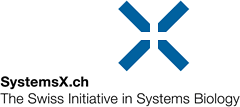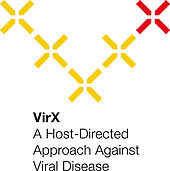VirX
A Host-Directed Approach Against Viral Disease
Viruses are a major threat to human health, as evidenced by recurring flu epidemics, the recent Ebola outbreak in Africa and the many other viral epidemics around the world. Antiviral drugs commonly target viral proteins and often lose their efficacy due to viral mutations. An alternative strategy, less prone to eliciting resistance, is to target the cellular processes exploited by viruses. The VirX Project aims to elucidate one novel cellular pathway that the influenza virus uses to infect human cells.
The VirX project builds on novel findings by the team members, who have identified the role of several cellular proteins in mediating infection by the Influenza virus (IAV). These proteins comprise HDAC6, dynein and myosin motors as well as the small protein ubiquitin. They all take part in a cellular detoxification process which deposits misfolded proteins in large aggregates, or aggresomes, where they are then degraded.
The influenza virus uses this pathway to its advantage. Filled with ubiquitin, IAV mimics pre-aggresomes and is subject to mechanical forces from motor proteins. This allows the efficient release of the viral genome into the cytosol of the host cells, from where it can enter the nucleus for transcription and replication.
The aim of VirX is to describe the molecular interactions involved in the mimicking of a pre-aggresome, and to exploit this knowledge for novel therapeutic approaches to combating viral disease. A second, related aspect of the work is to clarify the mechanism by which the ubiquitin proteasome system (UPS) supports the infection of human cells by rhinoviruses.
VirX will take an interdisciplinary systems approach to dissecting these processes at several levels. The main goals are:
- to analyze the interactions between the different proteins and develop 3-dimensional structural models
- to test various viruses for their dependence on the aggresome and UPS pathways, using cellular and mouse models
- to measure the ubiquitin levels and activity of these pathways in clinical specimens and correlate them with infectivity
- to generate pathway inhibitors or modulators in order to interfere with viral infection, potentially leading to novel antiviral drugs
- to use reconstituted human respiratory epithelium to test inhibitors or modulators that could interfere with viral infection
- to develop mathematical models that mechanistically link molecular interactions to host responses, and to use model simulations of dynamic infection data to predict previously unknown system properties
The VirX project bridges basic molecular biology and virology with advanced mathematical modeling, and delivers innovation with high potential for applications in the development of new antiviral therapies.
| Principal Investigator | Prof. Patrick Matthias, Friedrich Miescher Institute for Biomedical Research |
| Involved Institutions | FMI, UZH, UniGE/HUG, ETHZ, UniL/CHUV |
| Number of Research Groups | 7 |
| Project Duration | May 2015 – Apr. 2018 |
| Approved SystemsX.ch Funds | CHF 2.250 million |
Updated September 2015


